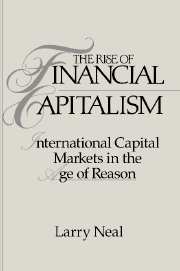Book contents
- Frontmatter
- Contents
- Acknowledgments
- 1 Historical background for the rise of financial capitalism: commercial revolution, rise of nation-states, and capital markets
- 2 The development of an information network and the international capital market of London and Amsterdam
- 3 The early capital markets of London and Amsterdam
- 4 The Banque Royale and the South Sea Company: how the bubbles began
- 5 The Bank of England and the South Sea Company: how the bubbles ended
- 6 The English and Dutch East Indies companies: how the East was won
- 7 The integration of the English and Dutch capital markets in peace and war
- 8 The English and Dutch capital markets in panics
- 9 The capital markets during revolutions, war, and peace
- 10 A tale of two revolutions: international capital flows, 1792–1815
- 11 The Amsterdam and London stock markets, 1800–25
- Appendix End-of-month share prices
- Bibliography
- Index
10 - A tale of two revolutions: international capital flows, 1792–1815
Published online by Cambridge University Press: 25 March 2010
- Frontmatter
- Contents
- Acknowledgments
- 1 Historical background for the rise of financial capitalism: commercial revolution, rise of nation-states, and capital markets
- 2 The development of an information network and the international capital market of London and Amsterdam
- 3 The early capital markets of London and Amsterdam
- 4 The Banque Royale and the South Sea Company: how the bubbles began
- 5 The Bank of England and the South Sea Company: how the bubbles ended
- 6 The English and Dutch East Indies companies: how the East was won
- 7 The integration of the English and Dutch capital markets in peace and war
- 8 The English and Dutch capital markets in panics
- 9 The capital markets during revolutions, war, and peace
- 10 A tale of two revolutions: international capital flows, 1792–1815
- 11 The Amsterdam and London stock markets, 1800–25
- Appendix End-of-month share prices
- Bibliography
- Index
Summary
The key historical event for the transformation of the international financial system in the period 1789–1825 was the success of Napoleon's Continental System, which disrupted the traditional British techniques for financing wars on the European continent, as it was intended to do. After 1808, when Napoleon perfected his Continental System, the exchanges of Britain with the Continent fluctuated violently, and from then on the government funds behaved quite differently. Instead of all three major stocks declining gradually in concert, the stocks of the Bank of England and the East India Company began to rise, with sharp fluctuations, whereas the Three Per Cents remained stable. How did the Continental System cause that regime change in the British financial markets?
The British success in fighting European wars had begun with the aid of William Ill's Dutch financiers in the War of the Grand Alliance (1688–97) and continued through the Seven Years’ War (1756–63). Figure 10.1 shows how the network of trade credit created by widespread use of the foreign bill of exchange was exploited by the British government to finance its armies on the European continent during the eighteenth century. The Exchequer purchased from London merchants bills of exchange that were drawn on their correspondents abroad, then sent the bills to the British quartermaster abroad, who used them locally to hire troops and purchase supplies. Because British manufactured goods and colonial reexports were in high demand in Europe, the bills drawn in London were accepted readily by the European merchants, who used them to pay for imports from Britain.
- Type
- Chapter
- Information
- The Rise of Financial CapitalismInternational Capital Markets in the Age of Reason, pp. 201 - 222Publisher: Cambridge University PressPrint publication year: 1991



